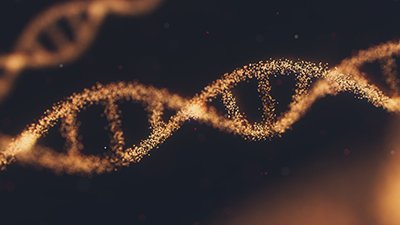
Evolution—A Framework in Which to Interpret Evidence
Reason 2: Evolution
Darwin’s remarkable realization that the diversity of life on Earth changes over time has now been tested in many different ways using many different types of science, from radiometric dating of fossils.
This statement doesn’t make any sense. Since when is the radiometric dating of fossils a way to show the diversity of life on earth or its changing? Creationists agree that the diversity of life changes over time, but it’s not millions of years like the evolutionists believe; rather, it is thousands of years in accordance with the Bible—not by molecules-to-man evolution, but by variation within kinds.
There is variation in dogs, but they are still dogs; variation in cats, but they are cats; variation in humans, but we are still humans—and so on.
to the science of genetics. Evolution provides a remarkable framework within which the current diversity of life on earth can be understood
Here the author makes a revealing admission that AiG is constantly pointing out: evolution is a framework in which to interpret evidence. It is a belief system that is foundational to the religion of humanism!
It is supported by every piece of data in modern biology and geology.
Every piece? That’s a pretty confident statement—without substantiation, in particular. Actually, data in modern biology and geology support the biblical framework! Allow us to give just one example to substantiate our claim: we observe in genetic studies mutations overwhelmingly cause a loss of genetic information. This indeed works in the opposite direction of what molecules-to-man evolution actually needs. For molecules-to-man evolution to be possible there has to be a mechanism that adds new genetic information—information that performs a new function that was not previously present. No such mechanism is known.
The fossil record is replete with transitional fossils of all sorts, including a continuous record of evolution from sea to land animals, and a remarkably complete record, containing hundreds of examples of the transition of hominid species to modern humans over a period of 5 million years.
Such as? This is a fallacy known as elephant hurling—making a broad claim and backing it up with sweeping generalities instead of fact. Actually, no such fossils exist. Because evolutionists start with an evolutionary framework (as the author(s) admitted), they therefore reinterpret evidence to fit what they already believe. Most evolutionists are aware of the fact that the fossil record contains no such transitional record (also see Get Answers: Fossils for more information):
Contrary to what most scientists write, the fossil record does not support the Darwinian theory of evolution because it is this theory (there are several) which we use to interpret the fossil record. By doing so, we are guilty of circular reasoning if we then say the fossil record supports this theory.1
[... the fossil record’s] incompleteness means that it is very likely that no fossil hominid yet found is on the direct line of descent to modern humans.2
There is no such thing as a missing link between humans and ape-like ancestors, all supposed ancestors can either be classified as a human or an ape (also see Get Answers: Anthropology for more information):
| Name | What is it?3 |
|---|---|
| Australopithecus afarensis (such as “Lucy”) | extinct ape |
| Australopithecus africanus | extinct ape |
| Australopithecus boisei | extinct ape |
| Australopithecus robustus | extinct ape |
| Pan troglodytes and Pan paniscus (chimpanzee) | living ape |
| Gorilla gorilla and Gorilla beringei (gorilla) | living ape |
| Pongo pygmaeus and Pongo abelii (orangutan) | living ape |
| Ramapithecus | extinct ape (extinct orangutan) |
| Homo habilis | false category that mixes some human and some ape fossils |
| Homo floresiensis | human (dwarf, pygmy) |
| Homo ergaster | human |
| Homo erectus (e.g., “Peking man” and “Java man”) | human |
| Homo neanderthalensis (Neanderthals) | human |
| Archaic Homo sapiens | human |
| Modern Homo sapiens | human |
The age determination of different human fossils is supported by a wealth of data, including radioactive dating, geological dating, and more recently genetic dating.
Radiometric dating, as we have seen, is replete with assumptions and has been shown inaccurate over and over again. If radiometric dating were accurate, then Mt. St. Helens didn’t really erupt in 1980 and 1982—but actually millions of years ago! [Ed. note: see “Excess Argon Within Mineral Concentrates from the New Dacite Lava Dome at Mount St Helens Volcano” for more information.]
The fossils are used to state the date for the layers, and the layers are used to state the date of the fossils!
Once again, geological dating is used to “confirm” geological dating! The fossils are used to state the date for the layers, and the layers are used to state the date of the fossils!
Genetic dating makes the assumption that mutations are splitting points in history among evolving organisms! So, they assume evolution is true to say this verifies it! Additionally, they are assuming that mutation rates are always constant for every part of the genome in every organism and that simply is not true. For example, bacterial populations can enter states in which mutations occur rapidly over a short period of time in an attempt to help the organisms adapt to a harsh environment. Thus, what looks like “millions of years” having passed is in fact only thousands of years or less.
Modern genetics, the study of DNA as the repository of information that is the basis for reproduction of life forms, allows detailed comparisons between species to be performed. The close genetic relationship between the human genome and that of great apes is one of the many pieces of data that imply that they are our closest genetic cousins on earth.
First, it is nowhere near as similar as people have been led to believe. I suggest John Sanford’s book on the subject, Genetic entropy and the mystery of the genome.
Notice one of the subjective terms used in the last sentence: “imply.” Similarities in the coding DNA of chimps and humans is not necessarily evidence of nor does it imply that humans and apes are closely related. Coding DNA contains the information for what proteins make up certain parts of the cells and, therefore, tissues, organs, and body. Coding DNA codes for the proteins that make up hair, skin, eyes, and so on. If we look at a chimpanzee, we see they have many similar parts like skin, hair, eyes, stomachs, teeth, bones, and so on. Just because chimps and humans both have skin and hair does not make them related, but it does show the efficiency and creativeness of God.
We also share about 50% of our DNA with bananas and that doesn’t make us half bananas.4
And just because a chimp has more chromosomes than a human does not mean that it evolved into a human, having simply lost or rearranged information in the DNA. For instance, a chicken has 78 chromosomes. And did you know that we share 60-75 percent DNA similarity with chickens? 5 Now, does anyone allege that if you take away 32 chicken chromosomes that you’ll get a human? Does that mean that we are closely related to chickens? Of course not.
Because mutation rates of various parts of the DNA sequence has been determined, one can use these as “molecular clocks” to determine how long it has taken for divergence between humans and great apes. It has been determined that the human-chimp divergence began around 4.5-5 million years ago, while the divergence between humans and gorillas (and chimps) occurred around 7 million years ago.
Please take note of such assumptions: Rate of mutation? Multiple mutations in one generation? Let’s be honest. Mutations are responsible for diseases that kill; they do not change chimps into humans! Mutations aren’t like science fiction where you get supernatural powers. In real life, they are more likely to cause cancer, Progeria, and so on.
Footnotes
- West, R. (Kansas State Univ.), “Paleontology and Uniformitarianism,” Compass 45:216, 1968.
- Jones, J.S., Department of Genetics and Biometry, University College London, in a book review from: Nature, Vol. 345, p. 395, 31 May 1990.
- This depends on an accurate classification, whether afarensis, neanderthalensis, etc. Most fossils would be this type, but, of course, there are always some exceptions that are classified incorrectly. With the human examples (archaic Homo sapiens, Homo erectus, etc.), it shows there is indeed variation within the created kind. This is same also with the various apes, showing great variation, as we would expect biblically.
- Jones, S., interviewed at the Australian Museum on The Science Show, broadcast on ABC radio, 12 January 2002, www.abc.net.au/rn/science/ss/stories/s456478.htm, 25 January 2002.
- http://www.genome.gov/12514316
Recommended Resources

Answers in Genesis is an apologetics ministry, dedicated to helping Christians defend their faith and proclaim the good news of Jesus Christ.
- Customer Service 800.778.3390
- © 2025 Answers in Genesis







